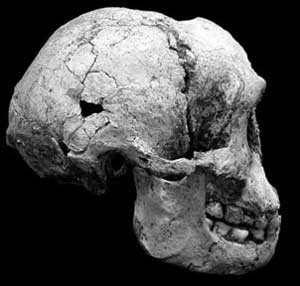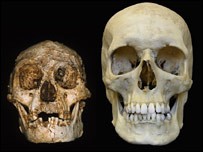The Discovery of the Hobbit Arrives in Australia
Posted by: Loren Coleman on November 29th, 2006
Please click on the book cover above for a fuller-sized version.
Professor Mike Morwood, Archaeology, University of New England, Australia, contacted me tonight to let me know that Random House (Australia) has published his new book on Homo floresiensis. The name of the book is The Discovery of the Hobbit: The Scientific Breakthrough that Changed the Face of Human History.

Morwood’s book is with Penny van Oosterzee, who is one of Australia’s best science writers, and is the recipient of the 1997 Eureka Science Book Prize for her book Where Worlds Collide: The Wallace Line. She is most-remembered for her highly-praised 2000 book, Dragon Bones: The Story of Peking Man. That volume detailed the emotional and compelling story of the Chinese Homo erectus. It is described as "a riveting historical account of the discovery of Peking Man, from the excavation of one small fossilized molar to the mysterious disappearance of the fossils at the beginning of the Second World War."

Mike Morwood’s and Penny van Oosterzee’s book has become one of the year’s most highly anticipated new books on palaeoanthropology, and specifically the subject of Homo floresiensis. The Hobbits are able to generate media attention globally. These 3-feet-tall hominids are so interesting to the general public, it seems clear that Morwood’s and van Oosterzee’s book will be an immediate success.

Morwood tells me the publication date is 2007 but, in Australia, at least, it will be available in bookshops before Christmas and can be ordered now.
The American version by the Smithsonian/Harper Collins, entitled A New Human, will be out by May 1, 2007.
About Loren Coleman
Loren Coleman is one of the world’s leading cryptozoologists, some say “the” leading living cryptozoologist. Certainly, he is acknowledged as the current living American researcher and writer who has most popularized cryptozoology in the late 20th and early 21st centuries.
Starting his fieldwork and investigations in 1960, after traveling and trekking extensively in pursuit of cryptozoological mysteries, Coleman began writing to share his experiences in 1969. An honorary member of Ivan T. Sanderson’s Society for the Investigation of the Unexplained in the 1970s, Coleman has been bestowed with similar honorary memberships of the North Idaho College Cryptozoology Club in 1983, and in subsequent years, that of the British Columbia Scientific Cryptozoology Club, CryptoSafari International, and other international organizations. He was also a Life Member and Benefactor of the International Society of Cryptozoology (now-defunct).
Loren Coleman’s daily blog, as a member of the Cryptomundo Team, served as an ongoing avenue of communication for the ever-growing body of cryptozoo news from 2005 through 2013. He returned as an infrequent contributor beginning Halloween week of 2015.
Coleman is the founder in 2003, and current director of the International Cryptozoology Museum in Portland, Maine.











Cool. Can’t wait to read. The book on the Peking Man was a great story.
One of the controversies over the Florensis skull is the cranial capacity for its size. Small brained for its height. This has been one reason that two camps have developed. One claims it is a new species of early human, while another claims it is an example of a modern type human with a genetic condition. Another controversy is based around the stone tools found. With such a small brain, says the camp that claims it to be a diseased person, they couldn’t have developed such fine tools. The other group is basically saying that there may well be more to intelligence than just brain size, so it could still be an offshoot long ago.
Some argue that floresiensis doesn’t warrant separate classification (because they are simply diminutive humans) whilst others disagree.
The link between “little people” stories and floresiensis has been talked about a number of times here on Cryptomundo also. A quick search should net you some interesting commentary! 🙂
The story of Homo floresiensis is really interesting in that it is a good example of how even something with hard physical evidence can produce wildly varying theories and opinions. I wonder if this same sort of thing will happen when, say, a Bigfoot skull is found? Is it going to raise more questions than it answers? I can imagine there are going to be conflicting theories and ideas. It is interesting to speculate about. I hope that the question can be answered once and for all what excactly Homo floresiensis is. Fascinating stuff and it looks like a compelling book.
mystery_man
Good science always produces more questions than answers, that is the nature of the beast so to speak. It simply leads to more learning and a better understanding of the whole question. No questions no learning. Thats why we communicate on this site to ask those all important questions and seek answers. When the truth is found, I have no doubt Cryptomundo is where it will be announced first. At least that’s where I will be looking.
Absolutely. That’s why I like science and teach it, have spent most of my life learning about it. It is the whole thing that fascinates me about it, the reason I ever became interested in it. This kind of opening of the way life works, of asking these questions and opening new theories compels me like nothing else does. I did not say that these questions that come up are a bad thing! Far from it. If every new mystery that we found was cut and dried, with simple answers, it would not hold the same appeal for me. If that were the case, I would not be on this site pretty much every day. I know this is the nature of the beast, and I wouldn’t have it any other way.
Here’s a link to a recent article at archaeology.org detailing arguments against the “hobbit” as a distinct species.